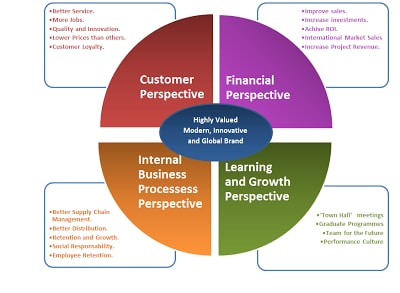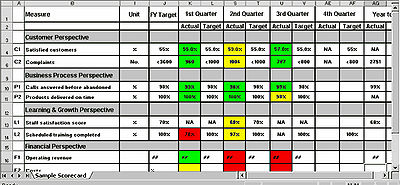Balanced scorecard in project management
| Line 83: | Line 83: | ||
| − | Indifference often causes customers to look for another vendor who may offer a better treatment. Some surveys demonstrate that unhappy customers tend to tell an average of 12 people the problems they had with that particular vendor. | + | Indifference often causes customers to look for another vendor who may offer a better treatment. Some surveys demonstrate that unhappy customers tend to tell an average of 12 people the problems they had with that particular vendor. <ref name=''9''> ''“Bizmonthly”, 1997'' </ref> |
| + | It is clear how this problem has repercussions on a very great scale, making the company face bigger problems and losses as a result of indifference and lack of empathy. | ||
| Line 102: | Line 103: | ||
= '''Procedure of construction of the balanced scorecard''' = | = '''Procedure of construction of the balanced scorecard''' = | ||
| − | + | <ref name=''6''> | |
Revision as of 11:00, 23 September 2016
The balanced scorecard approach was proposed for the first time by Robert S. Kaplan in 1992 in the article “The Balanced Scorecard – Measures that drive performance”, published in the Harvard Business Review.
The balanced scorecard is a strategic planning and management system broadly used in many types of organizations to align business activities to the vision and strategy of the organization, improve internal and external communications, and monitor organization performance against strategic goals [1]. The new idea claimed that an exclusive financial approach to measure the performance was not enough to have a complete idea of the business, or to reveal the business areas afflicted with problems and to point out areas for improvement. A project, in fact, has numerous aspects and an organization cannot afford not to consider all of them when evaluating the aforementioned project. Evaluating these aspects separately would likely lead to a sub-optimization of one or more aspects, and consequently would make the organization miss its long-term objectives.
For these reasons, the balanced scorecard (BSC) involves four key business aspects: financial perspective, customer perspective, internal business perspective, learning and growing perspective, each providing an overall view on all the organization through measurable goals and outcomes. What makes the notable, positive difference between this approach and other existing tools is that all the needed measurements are presented in a single report: this clarity is exactly what avoids the sub-optimization and guarantees the pursuit of the entire organization’s interests. [2]
Contents |
The balanced scorecard approach
“A project is a unique process consisting of a set of coordinated and controlled activities with start and finish dates, undertaken to achieve an objective conforming to specific requirements including constraints of time, cost and resources.” [3]
The definition of project, as provided by ISO 10006:2003, highlights how a project is made up of processes and procedures which involve a large set of activities and tasks that need to be organized and controlled through a precise method. However, every project can be characterized by three fundamental aspects that deeply change the approach to project management:
- Complexity. Many activities and individuals are involved in the development of a project and the interactions between them strongly effect and, in turn, complicate their tasks.
- Unpredictability. No matter how accurate the planning of a process may be, many times the results are do not yield what is expected. This creates another layer of complexity.
- Ambiguity. Due to the complexity and unpredictability, it is difficult to understand what is actually occurring during the development of a project. Hence, in order to understand the actual situation, it is paramount to pay particular attention all the indicators that provide the greatest value. [4]
In a similar context, it is clear that the balanced scorecard helps to clarify the vision of the whole organization, providing information about all areas of business, without sub-optimizing only one of them.
Since projects can be considered “mini organizations”, each requiring a strong control of the current situation, the BSC is a powerful tool for project management, providing continuous checks throughout the project life cycle.
All projects are built around some key business objectives: high productivity, high quality, on time delivery, growth of market share, utilizing resources effectively and efficiently. However, in the BSC approach, project managers are required to choose and customize those indicators that better fit the specific needs of that project. When a project manager takes into account all of the four perspectives that characterized the project, he will start to understand what activities can have a better influence on the project and what impacts it can have on the entire organization.
The objectives of the balanced scorecard approach are to:
- Ensure that measures support the organization’s core values;
- Choose efficient, effective and meaningful performance indicators to check project health throughout the project life cycle;
- Align the measures against the project’s charter; [5]
In order to obtain an easier and faster impact for the reader, the BSC models use the “stoplight” color scheme.In this way, it visually captures the reader’s attention to the areas that mainly deserve corrective activities and decisions.
It uses the green color, if the measured performances follow what was decided in the planning phase of the project and if it is aligned with stakeholders’ expectations. The yellow color is used if some little deficiencies are shown, and the red color if some serious deficiencies have been detected. Furthermore, the information provided with the colors are supported by numerical data showing a percentage of health of the project with respect to what was planned.
In the case of green color, no further actions are required.
In the case of yellow color, the report wants to give an alarm in order to signal that some aspects have to be monitored and some action may be necessary in the near future.
In the case of red color, the project manager is told that worrisome problems have been found and the project can be in jeopardy. Sudden actions are to be implemented and a special attention is to be given to those factors involved in those indicators.
The four perspectives
[6]  As previously stated, in order to supply a complete view of the project’s situation, besides the traditional financial indicators, the balanced scorecard involves three other key business aspects, each one showing a particular side of the organization through measurable goals and outcomes. The four perspectives provided by the BSC approach are:
As previously stated, in order to supply a complete view of the project’s situation, besides the traditional financial indicators, the balanced scorecard involves three other key business aspects, each one showing a particular side of the organization through measurable goals and outcomes. The four perspectives provided by the BSC approach are:
1- Financial perspective: evaluates the financial situation exploiting the traditional economic indicators (such as revenue growth, profit growth, etc.).
2- Customer perspective: evaluates how current and future customers look at the organization, through particular indicators that may be customer retention, customer satisfaction, market share, etc.
3- Internal business process perspective: evaluates the health of the activities and processes occurring inside the organization by means of practical indicators (cycle time, speed of services, etc.).
4- Learning and growing perspective: evaluates how the organization supports and encourages those activities that create innovation and growth in both processes and individuals involved. Some useful indicators for this perspective may be effectiveness of change to technology and processes, speed and frequency of changes, etc.
The financial perspective
The financial perspective deal with the cons takes into account the perspective of the stakeholders of the project. The main aspect to be investigated is the revenue gained from the outcome. A project should bring as much value as possible to the organization and, thus, the indicators involved in this perspective should reflect profitability and growth and show whether the project follow the organization’s overall strategy. The financial perspective may look the most important, but it is paramount to highlight how it is often the result of what the management do to handle the other ones.
The customer perspective
The customer perspective must take into consideration the market value of the project derivable as well as stakeholders’ satisfaction. It highlights that the project is managed in a global environment and that its aim is not satisfy the project’s sponsor, but rather to satisfy the customers’ need. The customer view reflects the level of service and quality provided by the organization as well as the resulting cost. Hence, the main point in this perspective is the alignment between the project outcomes and the customer’s expectation that is not always easy to get.
According to a customer satisfaction survey by The Marketing Science Institute of Cambridge, Massachussets (Smart Workplace Practices, 1996), customers’ expectations include the following characteristics:
- Reliability. Customers ask that the project be dependable and consistent and demand promises to be kept.
- Responsiveness. Continuous communication as well as a fast delivery is often a key aspect in order to manage a cooperative project.
- Assurance. Confidence between organization and customer is paramount to achieve the best results.
- Empathy. Customers really care about how they are treated and this often implies understanding beyond the contractual arrangements. Dealing with the customers as a partner or team member really help to build a durable and consistent relationship between the members of the project. [8]
Indifference often causes customers to look for another vendor who may offer a better treatment. Some surveys demonstrate that unhappy customers tend to tell an average of 12 people the problems they had with that particular vendor. [9]
It is clear how this problem has repercussions on a very great scale, making the company face bigger problems and losses as a result of indifference and lack of empathy.
The internal business process perspective
The goal of the internal process perspective is to evaluate anything that can influence the development of the project, the products and the services offered. It is important here to create maps of every process and activity involved in the project, as well as support a continuous improvement process. It involves all the core competencies of the project team members as well as the factors that determine the project life cycle. The question that the organization has to ask itself is “At what do we need to excel?”, in order to find out the most important areas where the project manager has to concentrate to achieve the best results for the project and for the whole organization. The content of this perspective incorporates what has been decided during the planning phase of the project, in order to allow the managers to evaluate timeliness, performance and costs resulting in the project life cycle.
The learning and growing perspective
The modern business environment changes very suddenly and the organization must continually evolve in what it offers to keep the pace. In the same way projects, especially long-lasting ones, have to continually analyze the environment in which they work, in order to be sure that the condition and basis used to build the planning phase are not changed.
During the development of the project, the team members have to be innovative and learn new ways of doing their tasks and approaching the problems they will face. The ability of growing throughout the life cycle reflects the organization’s expertise. Working in a project is supposed to provide the possibility of an individual and personal improvement as well as an occasion to bring a positive impact in the whole organization. When this perspective is analyzed, it is important to use indicators that show the commitment in a long-run view, and to support the work with as many as possible tools for conserving and transmitting the knowledge obtained during the project.
Procedure of construction of the balanced scorecard
Cite error:
<ref> tags exist, but no <references/> tag was found
